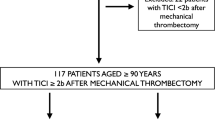Abstract
Glycoprotein (GP) IIb/IIIa inhibitors block the final common pathway of platelet aggregation by preventing fibrinogen from binding to the GP IIb/IIIa platelet receptor. In patients with unstable angina (UA) or a non–Q wave myocardial infarction (NQWMI), including those with UA refractory to medical therapy, these agents decrease the risk of death, myocardial infarction (MI), and recurrent ischemia. Most patients with acute coronary syndromes are managed in hospitals without on-site angioplasty capabilities and often require transfer for an interventional procedure. We propose that GP IIb/IIIa inhibitors can be safely initiated at the referring hospital. We studied 20 patients with UA/NQWMI in whom therapy with a GP IIb/IIIa inhibitor, in addition to standard medical therapy, was initiated prior to transfer for an urgent percutaneous coronary intervention (PCI) (“drip and ship”). The primary end point was a composite of death, MI, and recurrent ischemia at 30 days. Twelve patients were treated with abciximab, 5 patients were treated with tirofiban, and 3 patients initially treated with tirofiban were converted to abciximab. Procedural success occurred in 33 out of 36 (92%) lesions and 18 out of 20 (90%) patients. At 30 days, 4 out of 20 (20%) patients had recurrent ischemia. The PTCA sites were widely patent in the 3 patients who underwent repeat angiography. The fourth patient had an unsuccessful PCI and was referred for coronary artery bypass surgery. There were no MIs or deaths. Patients who require transfer for an urgent PCI can be managed safely and efficaciously by initiating a GP IIb/IIIa inhibitor, in addition to standard medical therapy, prior to transfer.
Similar content being viewed by others
References
Coller BS. Blockade of the platelet Gp IIb/IIIa receptors as an antithrombotic strategy. Circulation 1995;92:2373-2380.
The Platelet Receptor Inhibition in Ischemic Syndrome Management in Patients Limited by Unstable Signs and Symptoms (PRISM-PLUS) study investigators. Inhibition of the platelet glycoprotein IIb/IIIa receptor with tirofiban in unstable angina and non-Q wave myocardial infarction. N Engl J Med 1998;338:1488-1497.
The PURSUIT Trial Investigators. Inhibition of platelet glycoprotein IIb/IIIa with eptifibatide in patients with acute coronary syndromes. N Engl J Med 1998; 339:436-443.
The EPISTENT Investigator. Randomised placebo-controlled and balloon-angioplasty-controlled trial to assess safety of coronary stenting with use of platelet glycoprotein IIb/IIIa blockade. Lancet 1998;352:87-92.
The CAPTURE Investigators. Randomised placebocontrolled trial of abciximab before and during coronary intervention in refractory unstable angina: The CAPTURE study. Lancet 1997;349:1429-35.
Kong DF, Califf RM, Miller DP, et al. Clinical outcomes of therapeutic agents that block the platelet glycoprotein IIb/IIIa integrin in ischemic heart disease. Circulation 1998;98:2829-2835.
Ryan TJ, Bauman WB, Kennedy JW, et al. Guidelines for percutaneous transluminal coronary angioplasty: A report from the American College of Cardiology/ American Heart Association task force on assessment of diagnostic and therapeutic cardiovascular procedures (committee on percutaneous transluminal coronary angioplasty). J Am Coll Cardiol 1993;22: 2033-2054.
Braunwald E. Unstable angina: A classification. Circulation 1989;80:410-413.
Hamm CW, Goldman BU, Heeschen C, Kreymann G, Berger J, Meinertz T. Emergency room triage of patients with acute chest pain by means of rapid testing for cardiac troponin T or troponin I. N Engl J Med 1997;337:1648-1653.
Peterson JG, Lauer MA, Sapp SK, Topol E. Heparin use is required for clinical benefit of Gp IIb/IIIa inhibitor eptifibatide in acute coronary syndromes: Insights from the PURSUIT trial. Circulation 1998; 98:360.
The EPIC investigators. Use of monoclonal antibody directed against the platelet glycoprotein IIb/IIIa receptor in high-risk coronary angioplasty. N Engl J Med 1994;330:956-961.
Mascelli MA, Lance ET, Damaraju L, Wagner CL, Weisman HF, Jordan RE. Pharmacodynamic profile of short-term abciximab treatment demonstrates prolonged platelet inhibition with gradual recovery from Gp IIb/IIIa receptor blockade. Circulation 1998;97:1680-1688.
Topol EJ, Ferguson JJ, Weisman HF, et al. Long-term protection from myocardial ischemic events in a randomized trial of brief integrin b3 blockade with percutaneous coronary intervention. JAMA 1997;278: 479-484.
Gawaz M, Neumann FJ, Dickfeld T, et al. Vitronectin receptor (avb3) mediates platelet adhesion to the luminal aspect of endothelial cells; Implications for reperfusion in acute myocardial infarction. Circulation 1997;96:1809-1818.
Topol EJ. Toward a new frontier in myocardial reperfusion therapy: Emerging platelet preeminence. Circulation 1998;97:211-218.
Ellis SG, Lincoff AM, Miller D, et al. Reduction in complications of angioplasty with abciximab occurs largely independently of baseline lesion morphology. J Am Coll Cardiol 1998;32:1619-1623.
Author information
Authors and Affiliations
Rights and permissions
About this article
Cite this article
Chadow, H.L., Hauptman, R.E., VanAuker, M. et al. Drip and Ship: A New Strategy for the Treatment of Acute Coronary Syndromes. J Thromb Thrombolysis 10, 77–82 (2000). https://doi.org/10.1023/A:1018707023127
Issue Date:
DOI: https://doi.org/10.1023/A:1018707023127




